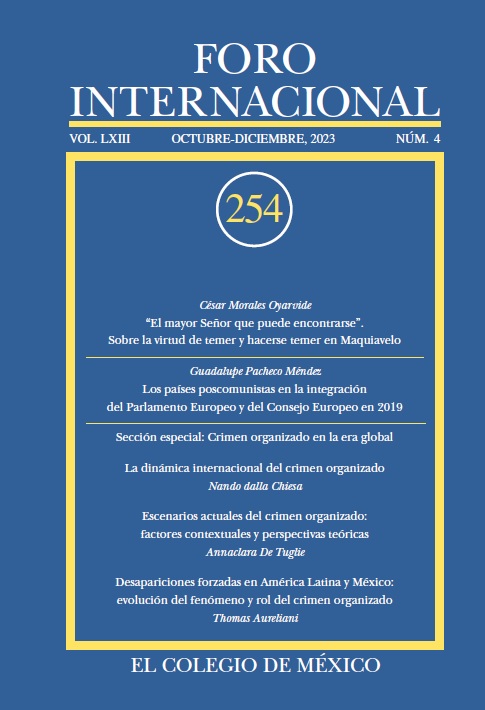Forced disappearances in Latin America and Mexico: evolution of the phenomenon and the role of organized crime
DOI:
https://doi.org/10.24201/fi.v63i4.3024Keywords:
organized crime, drug trafficking, mafia, money laundering, forced disappearance, extortion, Mexico, ItalyAbstract
The severe crisis of insecurity and human rights in contemporary Mexico demands from academia a profound analysis of the phenomenon of organized crime, informed by international experiences and sensitive to its dual nature as a phenomenon with deep local roots that is, simultaneously, inseparable from the flows of the global economy. Against this backdrop, in March 2023, the seminar “Dialogues from the Frontiers of Organized Crime: Organized Crime, Rights, and Educational Poverty” was held at El Colegio de México, in collaboration with the University of Milan, the Embassy of Italy in Mexico, the Pontifical International Marian Academy, the Mexican Institute for Justice, and the Memory and Tolerance Museum.
During the seminar, scholars, analysts, and officials examined the penetration of organized crime into the political, social, and economic life of Mexico and other Latin American countries, with special attention to the parallels and lessons that can be drawn from the Italian experience. In Italy, as in Mexico today, the historical intertwining of crime with economic and social relations has confronted the state, political elites, and civil society with the need to initiate extraordinary processes of memory, truth, justice, and institutional reconstruction.
Due to the significance of the topic and the introduction of analytical perspectives useful for studying criminal dynamics and its implications, we reproduce three presentations from the seminar. In the first, Nando dalla Chiesa, a prominent sociologist, intellectual, professor at the University of Milan, and emblematic figure of the Italian anti-mafia movement, outlines three approaches to the study of criminal dynamics at the international level. These approaches include the process of multiplication of criminal organizations on a global scale, the proliferation of mercenary armies and paramilitary forces, and the growing interconnection between crime and political terrorism. Dalla Chiesa also reflects on the difficulties in distinguishing criminal activity from the rest of economic and social interaction. Phenomena like money laundering increasingly blur the boundaries between society and crime, formal and informal economy, businesspeople and criminals, legality and illegality.
In the second presentation, Annaclara De Tuglie reflects on the levels of analysis in the study of organized crime, ranging from a “macro” perspective that addresses the geopolitical and transnational components of the phenomenon (such as migration, capital flows to tax havens, among others) to the “micro” level, which focuses on individual and local experiences in dealing with crime and the conditions that facilitate its reproduction. Finally, leveraging the analytical tools discussed in the other presentations, Thomas Aureliani provides an overview of the phenomenon of forced disappearances in Mexico, based on his own fieldwork and testimonies from family members of victims of a crime that starkly reflects the crisis of stateness and human rights overshadowing the country.
Downloads
References
AURELIANI, T., “Las desapariciones de personas en México: una aproximación al perfil del fenómeno desde una perspectiva regional. El caso de Coahuila”, Rivista di studi e ricerche sulla criminalità organizzata, vol. 6, núm. 1. (2020), pp. 57-84.
AURELIANI, T., Vivi li rivogliamo! La mobilitazione dei familiari dei desaparecidos in Messico, Sesto San Giovanni, Meltemi, 2022.
CartoCrítica, Investigación, mapas y datos para la sociedad civil, https://cartocritica.org.mx/
Comisión Interamericana de Derechos Humanos (CIDH), Caso Radilla Pacheco vs. México, Sentencia de 23 de noviembre 2009.
Comisión Interamericana de Derechos Humanos (CIDH), Informe sobre la situación de los derechos humanos en México, OEA/Ser.L/V/II Doc. 44/15, 2015.
Comisión Interamericana de Derechos Humanos (CIDH), México: Caso Alvarado Espinoza y otros vs. México. Sentencia de 28 de noviembre 2018.
Comisión Nacional de Derechos Humanos (CNDH), Recomendación 26/2001 de la Comisión Nacional de Derechos Humanos, Recomendación 026/2001, México, D. F., 27 de noviembre de 2001, https://odim.juridicas.unam.mx/sites/default/files/CNDH%20-%20Rec%202001_26.pdf
Congressional Research Service, Mexico: Organized Crime and Drug Trafficking Organizations, Congressional Research Service R41576, 2022, p. 10, https://crsreports.congress.gov/product/pdf/R/R41576
CORREA-CABRERA, G., Los Zetas Inc.: la corporación delictiva que funciona como empresa trasnacional, México, Editorial Planeta, 2018. DOI: https://doi.org/10.7560/312742
DULITZKY, Ariel E., “The Latin-American Flavor of Enforced Disappearances”, Chicago Journal of International Law, vol. 19, núm. 2 (2019), pp. 423-489.
“El país de las 2 mil fosas”, A dónde van los desaparecidos, https://data.adondevanlosdesaparecidos.org/
Federación Internacional de Derechos Humanos (FIDH), México: Asesinatos, desapariciónes y torturas en Coahuila de Zaragoza constituyen crímenes de lesa humanidad, Comunicación de acuerdo con el artículo 15 del Estatuto de Roma de la Corte Penal Internacional, Federación Internacional de Derechos Humanos, París, Francia, 2017.
Gobierno de México, Secretaría de Gobernación, Registro Nacional de Personas Desaparecidas y No Localizadas (RNPDNO), https://comisionacionaldebusqueda.gob.mx/rnpdno/
Human Rights Clinic, Control… sobre todo el estado de Coahuila. Un análisis de testimonios en juicios contra integrantes de los Zetas en San Antonio, Austin y Del Rio, Texas, Human Rights Clinic/The University of Texas School of Law, Austin, 2017.
LOAEZA, S., “La metamorfosis del Estado: del jacobinismo centralizador a la fragmentación democrática” (pp. 23-70), en Soledad Loaeza y Jean-François Prud’homme (coord.), Los grandes problemas de México. Instituciones y procesos políticos, t. XIV, México, Colegio de México, 2010.
MASTROGIOVANNI, F., Ni vivos ni muertos: La desaparición forzada en México como estrategia de terror, México, Grijalbo, 2014.
Naciones Unidas, Comité contra la Desaparición Forzada (CDF), Informe del Comité contra la Desaparición Forzada sobre su visita a México en virtud del artículo 33 de la Convención Internacional para la Protección de Todas las Personas contra las Desapariciones Forzadas, 18 de mayo de 2022, CED/C/MEX/VR/1.
Poder Ejecutivo, Presidencia de la República, “Acuerdo por el que se disponen diversas medidas para la procuración de justicia por delitos cometidos contra personas vinculadas con movimientos sociales y políticos del pasado”, Diario Oficial de la Federación, 27 de noviembre de 2001, https://www.dof.gob.mx/nota_detalle.php?codigo=758894&fecha=27/11/2001#gsc.tab=0
ROBLEDO SILVESTRE, C., “El laberinto de las sombras: desaparecer en el marco de la guerra contra las drogas”, Estudios Políticos, núm. 47 (2015), pp. 89-108. DOI: https://doi.org/10.17533/udea.espo.n47a06
RODRÍGUEZ FUENTES, Ó. D., “Historia de la desaparición en México: perfiles, modus y motivaciones”, Derecho y Ciencias Sociales, 1(17) (2017), pp. 247-271. DOI: https://doi.org/10.24215/18522971e018













